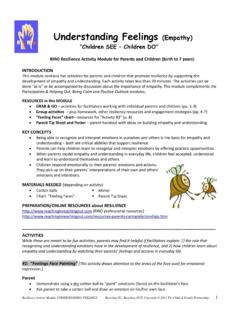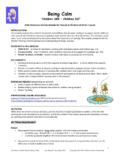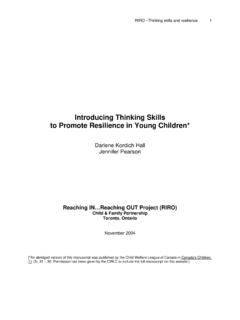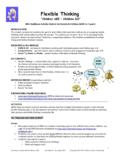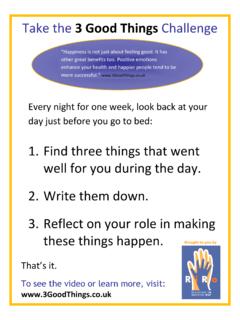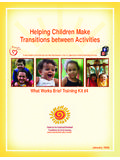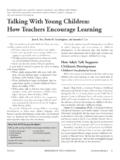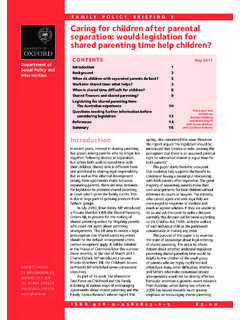Transcription of “Children SEE – Children DO”
1 Resiliency Activity Module-Perseverance Reaching OUT, Copyright 2012 The Child & Family Partnership 1 Keep Trying (Perseverance) Children SEE Children DO RIRO Resilience Activity Module for Parents and Children (birth to 7 years) INTRODUCTION This module contains fun activities for parents and Children that promote resilience by encouraging perseverance. Each activity takes less than 20 minutes. The activities can be done as is or be accompanied by discussion about the importance of persevering. This module complements Flexible Thinking, Being Calm and Understanding Feelings modules. RESOURCES in this MODULE GRAB & GO activities for facilitators working with individual parents and Children (pp.)
2 1-2) Group activities plus homework, other resiliency resources and engagement strategies (pp. 3-5) Parent Tip Sheet and Poste parent handout with ideas on activities that support perseverance KEY CONCEPTS The ability to keep trying when things don't work at first supports our resilience by helping us develop necessary skills and solutions. Accomplishment may take many steps and lots of practice. Making mistakes and asking for help are just part of learning new things. When parents model perseverance and show that mistakes are OK, Children learn to keep on trying. Encouragement to keep trying, as opposed to instruction, can help Children feel proud of their accomplishments. MATERIALS NEEDED (depending on activity) Paper, scissors Pencil, crayon, markers Cotton balls or wads of paper Watch with second hand or timer PREPARATION/ ONLINE RESOURCES (RIRO professional resources) p o t /8 5-The-Wall ( V ideo a boy perseveres in learning to build a brick wall with his father s support.
3 ---------------------------------------- ---------------------------------------- ---------------------------------------- ------------------- ACTIVITIES While these are meant to be fun activities, parents may find it helpful if facilitators explain: 1) the role that perseverance plays in the development of resilience, and 2) how Children learn to keep trying by watching their parents persevere in everyday life. #1: Keep on Trying Wiggle Parent Explain the main activity (see activity description on p. 2 under Parent and child ) Help parent plan for the activity by discussing: o What will help the child to keep trying? Resiliency Activity Module-Perseverance Reaching OUT, Copyright 2012 The Child & Family Partnership 2 o What encouraging things can the parent say?
4 O Highlight modeling, encouragement, patience and acceptance of mistakes. (Optional) You may also wish to talk with the parent about what has helped him/her persevere in the past help parent to realize what is helpful to him/her may also help the child keep trying. Ask parent: o What helped you to face a situation that required you to keep trying? o What were your thoughts about trying again and again? o What are things others did that helped you? o What did you want to hear from others? Parent and child Use a ball or balloon or other handy object ( , Kleenex box, toilet paper roll). Have parent and child hold the ball between their bodies while standing face-to-face. Without the ball falling, the goal is to try to move: o across the room o through a door.
5 This activity can also be done in a sitting position on the floor (side-to-side) ( , ball is between parent and child s hips or shoulder). Encourage parent and child to keep on trying to accomplish activity. #2: Cotton ball hockey (parent and child) Use a cotton ball (or small paper wad) for the puck . The parent and child then blow the puck across the table or floor. Parent and child can be across from each other and try to get a goal by blowing the puck into the other's hands, or other defined spot on opposite ends. Parents and child can work together to blow the puck into a specific place ( the goal ). Help parent to think of a slightly harder task ( , a smaller goal or one further away).
6 Encourage parent and child to persist in practicing. When that is done, another goal can be set. Parent and child can see themselves, as they practice, getting better on making goals. Can give stars or high fives each time parent and child get closer to the goal. #3: Perseverance paper puzzle (parent and child) Draw a picture and cut (or tear) it into pieces. (It may be more meaningful if it is the child's hand or foot tracing, or a picture of something they want to do or be in the future.) See how fast parent and child can put it together. Repeat, then try again and again. Comment on how the child gets faster (or more creative, or neater, or more confident or calmer, etc.) with repetition. #4: Perseverance story (parent and child) Read story about a character who perseveres (see suggested books on p.)
7 5). Have parent ask what else the character could do, and then, tell child the benefits of perseverance. #5: Parent and infant activities Pick a developmentally-appropriate task and plan with the parent how to encourage the child to meet the task, , learning to take food from a spoon. Help parent start with small steps to accomplish this , help infant to get used to seeing the spoon, then touching the spoon, feeling the spoon on lips, spoon in the mouth, spoon with food, etc. Resiliency Activity Module-Perseverance Reaching OUT, Copyright 2012 The Child & Family Partnership 3 GROUP ACTIVITIES NOTE: These activities are designed for professionals and paraprofessionals who have completed RIRO Resiliency Skills Training Program and who have group facilitation experience.
8 Parent group (no Children ) Have parents do Activity #1 (parent version) starting on p. 1. Discuss the experience of doing the activity. Introduce content on perseverance. Ask: o What helps people keep on trying? o Has anyone helped them persevere? What did that person do? o What were their thoughts about keeping on trying ? Brainstorm and then have parents create a list of what they can do to help their Children persevere. (Make sure to highlight modeling, encouragement, patience, and acceptance of mistakes.) Share other perseverance activities (pp. 1-2) and Take home activities (see bottom this page). Parent-child group Have parents and Children do Activity #1 (parent-child version) on p. 2. Use descriptive feedback to comment on how continued trying helped them make progress.
9 Highlight modeling, encouragement, patience, and acceptance of mistakes. Discuss the importance of perseverance. Discuss differences in their performance, attitude to achievement and relationships. Parent and child pairs do another round of the same or another activity while parent focuses on encouragement, role modeling and fun. Discuss what helped their Children . Facilitators suggestions Some of these activities work better in group format than with individual parents. Facilitators can stage making mistakes by dropping the ball to role model that mistakes are OK. TAKE HOME OPTIONS (for individuals or group) Continue cotton ball hockey (or other fun activity) point out when child gets better with practice.
10 Say out loud the steps parent takes to get things done like making dinner, buying groceries, getting your child dressed this helps Children learn the need to persevere in everyday life. Share stories and real-life community examples of people who keep trying. By words and expression, parent lets child know s/he is pleased when the child keeps trying. Even infants can recognize a parent s attitude. To help Children stay calm when trying new things, parents can use a try three times, then take a break method. THINGS PARENTS CAN SAY TO THEIR Children Encouragement I see you re trying; I bet you ll get it soon. You figured it out. I bet we can learn something from this mistake what do you think?
